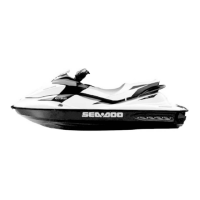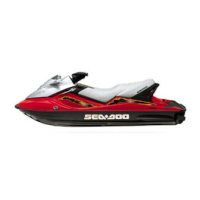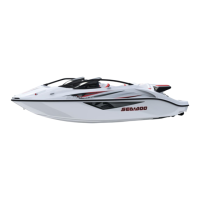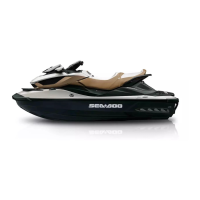NAVIGATION RULES
Navigation System
Navigational aids, such as signs or
buoys, can assist you in identify-
ing safe waters. Buoys will indicate
whether you should keep to the right
(starboard) or to the left (port) of the
buoy, or to which channel you can con-
tinue. They may also indicate whether
you are entering a restricted or con-
trolledareasuchasanowakeorlow
speed zone. They may also indicate
hazards or pertinent boating informa-
tion. Markers may be located on shore
or on the water. They can also indi-
cate speed limits, no power craft or
boating, anchorage and other useful
information. (The shape of each type
of marker will provide assistance).
Make sure you know and understand
the navigation system applicable to
the waterways where you intend to
use the watercraft.
Collision Avoidance
Do not release the throttle when try-
ing to steer away from an obstacle.
Engine power and jet pump thrust is
required to steer the watercraft.
Always keep a constant lookout for
other water users, other boats or ob-
jects, especially when turning. Be alert
for conditions that may limit your visi-
bility or block your vision of others.
Respect the rights of other recreation-
ists and/or bystanders and always
keep a safe distance from all other wa-
tercrafts, boats, people and objects.
Do not wake or wave jump, ride the
surf line or attempt to spray or splash
others with your watercraft. You may
misjudge the ability of the watercraft
or your own riding skills and strike a
boat or person.
This watercraft has the capabili
ty of
turning more sharply than other boats,
however, unless in an emergency, do
not negotiate sharp, high spee
d turns.
Such maneuvers make it hard for oth-
ers to avoid you or understand where
you are going. Also, you and/or your
passenger(s) could be thrown from the
watercraft.
Unlike most other watercrafts, this
PWC has a braking system (iBR).
When operating an iBR equipped wa-
tercraft, be aware that other boats fol-
lowing or operating in close proximity
may not be able to stop as quickly.
When at speed and the brake is first ap-
plied, a plume of water will shoot up in
the air behind the watercraft indicating
a braking manoeuvre.
It is important to inform the operator of
a watercraft who intends to follow in
a convoy formation of the braking and
maneuvering capability of your PWC,
what the plume of water indicates, and
that a greater distance should be main-
tained between both of you.
Stopping distance will vary depending
on initial speed, load, wind and water
conditions.
Although the preferable manoeuver to
avoidanobstacleisto steer awaywhile
applying throttle, the iBR can also be
used by fully braking and turning in the
direction to avoid the obstacle.
________
SAFETY INF
ORMATION
________
27

